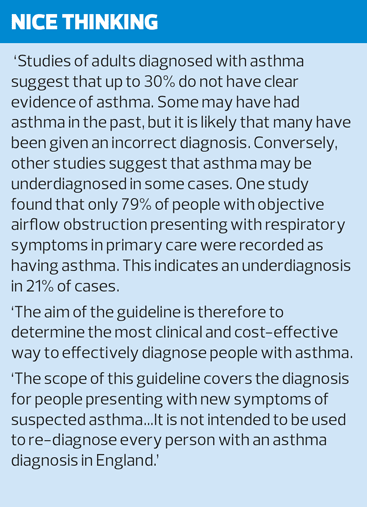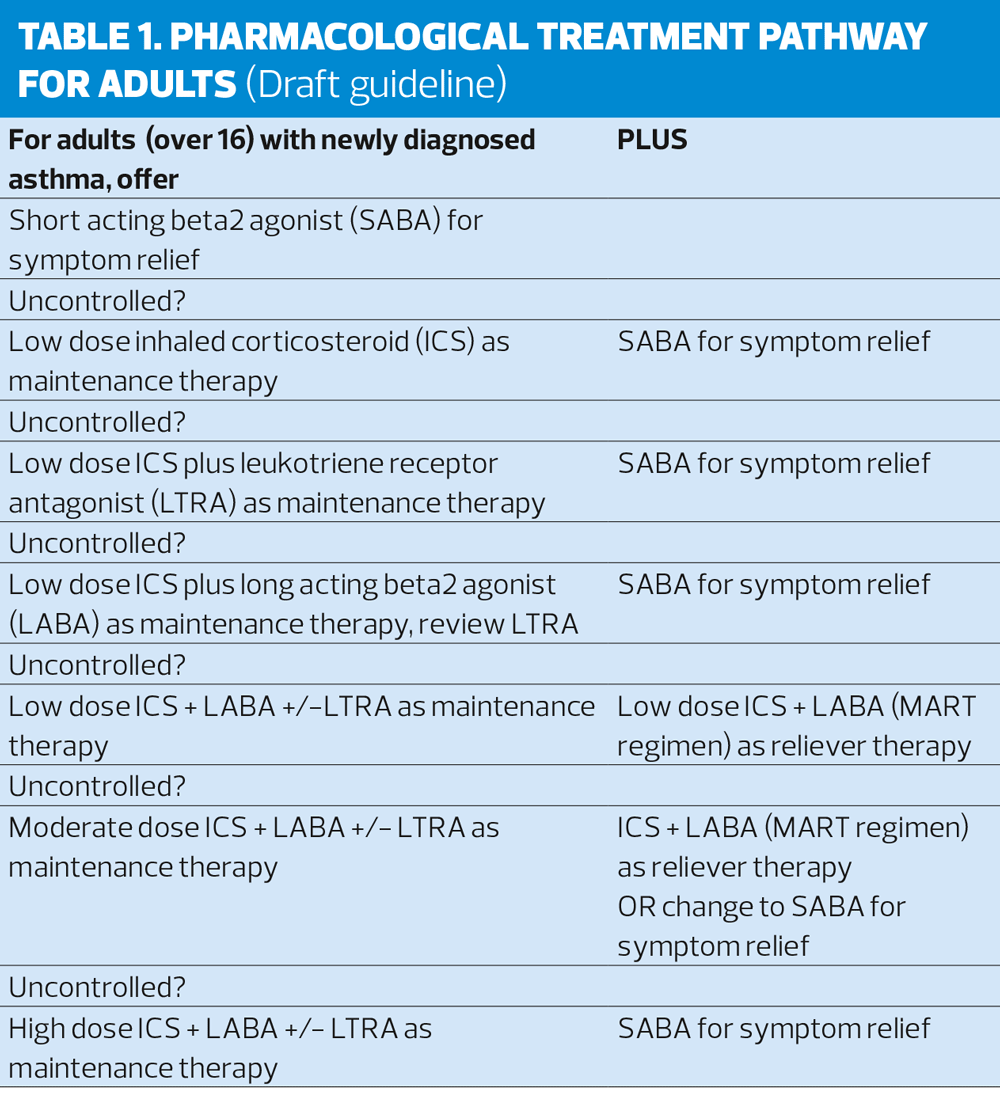
Multiple asthma guidelines — the challenge in clinical practice
CAROL STONHAM
CAROL STONHAM
MBE, QN
Nurse lead and Vice Chair, Primary Care Respiratory Society UK
Senior nurse practitioner (Respiratory), Gloucester CCG
The draft NICE guidance on diagnosis and management of asthma – due to be published this month but currently on hold – poses a dilemma for general practice nurses because in so many areas it is at odds with the current BTS/SIGN guideline: what should we do?
The long awaited NICE guidelines on Asthma: diagnosis and monitoring of asthma1 and Chronic asthma management2 have been further delayed while NICE discusses implementation plans with NHS England.
It was expected to released on 31 October, after delays and a period of feasibility testing in a small number of primary care sites. The field testing ran for a six month period and was designed to inform NICE on the feasibility of implementing the diagnostic algorithm, in particular the routine use of spirometry and FeNO (Fractional exhaled Nitric Oxide) in patients presenting with symptoms suggestive of asthma. The testing also explored the implications for staff training of wider use of objective testing in primary care.
The background to NICE looking for diagnostic improvement is from recent evidence showing that up to a third of patients with an asthma diagnosis now show no active signs or symptoms of the disease so may have been misdiagnosed. NICE is therefore expected to recommend that all patients aged 5 or over should undergo objective testing (including spirometry and FeNO) when they present with symptoms, or once acute symptoms settle. All patients over 5 should undergo spirometry testing, and all those over age 16 FeNO testing. Those aged over 5, if they have normal spirometry, or an obstructive result with negative reversibility should also have their FeNO checked to assist with diagnosis.
Historically the BTS/SIGN British Asthma Guideline3 has been the preferred approach for diagnosing asthma in the UK, although the GINA (Global Initiative in Asthma) Strategy is also available, and GINA has just launched its 2017 update.4 The BTS/SIGN Guideline was updated in November 2016 so also reflects current evidence, but gives different recommendations depending on a high, intermediate or low probability of asthma, based on a structured clinical assessment. BTS/SIGN still recommends using spirometry and FeNO, but only for those with an intermediate probability of asthma where further objective evidence is being sought.
MANAGEMENT
This is further complicated when looking at asthma management. The initial treatment for asthma remains low dose inhaled corticosteroids (ICS). There is agreement between the BTS/SIGN and NICE that in the majority of cases of asthma, underlying eosinophilic inflammation requires treatment with ICS. When treatment with low dose inhaled steroids is not enough to control symptoms, and an additional treatment is required (after checking inhaler technique, adherence with prescribed medication and trigger avoidance or minimisation), the BTS/SIGN guideline and the NICE guideline offer differing advice. BTS/SIGN suggests that adding in a long acting bronchodilator (LABA) in a combination inhaler is the preferred treatment based on the evidence, whereas NICE is expected to come down on the side of leukotriene receptor antagonists (LTRA) as the initial add-on to low dose inhaled steroids if control is inadequate.
Both guideline committees review all evidence available, so how can their conclusions be so different? The methodology and criteria for reviewing the evidence is different. Both undertake a full structured review of all available clinical evidence, however NICE follows this with an economic evaluation. This means NICE reviews the clinical evidence and the cost – and thus derives an assessment of the cost effectiveness of different options. NICE considers the effectiveness of LABAs to be broadly similar to LTRA, so when the cheaper cost of the latter is factored in, they are deemed to be the more cost effective option. This explains why BTS/SIGN (no health economic analysis) makes different recommendations about the choice of first line add-on to inhaled steroids from NICE (with health economic analysis).
But where does that leave the practising clinician when faced with a patient with a clinical picture suggestive of asthma? Should we be following BTS/SIGN as we have done for many years, or should we move across to NICE when it is published, as NICE guidance is our standard in so many other disease areas in the UK? Will we be able to move between guidelines depending on the patient in front of us? And if so how can we justify this in our record keeping?
In the case of diagnosis, our decision may at least partly be led by the availability of, or our access to objective testing and equipment. Currently few primary care practices have the equipment or knowledge to be able to offer FeNO, although maybe this should be our aim. It is unrealistic to refer every patient suspected of having a diagnosis of asthma into secondary care simply because we do not yet have the equipment or training to offer this in primary care. However, most practices already offer spirometry, and its usage will gradually be expanded into asthma diagnosis, since this is what both guidelines recommend. By 2021 it is expected that all healthcare professionals in England who are performing and/or interpreting diagnostic spirometry will have had their competence assessed, and will have joined the National register, so we are expecting to see many more clinicians undertaking training in spirometry.
Asthma is a condition that has been and should, generally, be diagnosed by primary care clinicians. NICE has suggested the service could be offered in primary care hubs – where the patients from several practices could have access to a diagnostic service. As a FeNO advocate I have been running a locality based service for some time and am lucky enough to work in a CCG where the value of such a service is recognised by commissioners, primary care, the integrated team and respiratory consultants. And the patients value it highly; this is borne out in the patient feedback.
COMPETING GUIDELINES
When competing guidelines exist, it can cause confusion for the generalist who does not know every detail of the disease, its treatment options or the evidence supporting decisions. Respiratory medicine is complicated enough with so many different inhaler devices, medications and combinations, without guidelines giving different advice. However, the ultimate judgement must still be made by the healthcare professional responsible for clinical decision making for the patient in front of them, and should only be arrived at following discussion of the options with the patient. Some will see guidelines as a rigid framework to work within, while others may consider them looser guidance.
However we work, the future will be one of making clinical decisions in the knowledge that there are asthma guidelines offering different recommendations at various stages of the diagnosis and treatment pathway. What is critical is that we document effectively in the notes our reasons for making the decisions we do, having discussed options with the patient. In some ways, having more than one guideline enables us to use our clinical judgement more, and to offer more personalised care to an individual patient, than if we had to comply with a single guideline. How we decide upon which guideline we follow may be determined by a number of influences – our knowledge base, local formularies and guidance, or that of specialist organisations.
A similar situation arose in the treatment of patients with chronic obstructive pulmonary disease (COPD). The NICE guideline for the treatment and management of COPD5 has guided COPD care since it was published in 2004 and updated in 2010. Now that newer evidence has emerged and the NICE guideline is outdated, guidance from the international Global Initiative for Chronic Obstructive Lung Disease (GOLD)6 has become more widely recognised in the UK. This was most recently updated in 2016 and published as the 2017 version, reflecting current evidence and a more targeted treatment strategy. Clinicians are in a similar situation with the management of people with COPD – should the NICE guideline be the guideline of choice, or should they follow the more recent international GOLD Guidelines?
The Primary Care Respiratory Society UK (PCRS-UK) considered this dilemma, and published excellent consensus-based guidance that sets out a simple treatment pathway based on the predominant characteristics of COPD for an individual – whether symptoms or exacerbations – distilled from current guidelines.7 This primary care-focused guidance has been developed by a group of clinicians working with and in primary care, and is titled ‘Going for Gold?’7
The Society is working on a similar piece for asthma, which will tease out a diagnosis and management pathway from the BTS/SIGN guideline and NICE guideline, and which should be practical for implementation in primary care.
I am always reminded that whichever guideline is chosen, we are in the business of people: ‘The typical asthma patient does not exist. Guidelines are not a rule book to constrain practice, but a tool to give individual patient care’. (ME Hyland, 1998)
REFERENCES
1. NICE. Asthma: diagnosis and monitoring of asthma in adults, children and young people. Clinical guideline. (Draft for consultation), July 2017. https://www.nice.org.uk/guidance/gid-cgwave0640/documents/draft-guideline
2. NICE. Asthma management (Draft for consultation), 2016. https://www.nice.org.uk/guidance/gid-ng10095/documents/draft-guideline-3
3. British Thoracic Society/Scottish Intercollegiate Guidelines Network. British guideline on the management of asthma, 2016. https://www.brit-thoracic.org.uk/document-library/clinical-information/asthma/btssign-asthma-guideline-2016/
4. Global Initiative for Asthma (GINA). Global strategy for asthma management and prevention, 2017. http://ginasthma.org/2017-gina-report-global-strategy-for-asthma-management-and-prevention/
5. Chronic obstructive pulmonary disease: management of chronic obstructive pulmonary disease in adults in primary and secondary care. National Clinical Guideline Centre (2010).
6. Global Initiative for Chronic Obstructive Lung Disease (GOLD). Report on the Global Strategy for the Diagnosis, Management and Prevention of COPD, (GOLD 2017). http://goldcopd.org/gold-2017-global-strategy-diagnosis-management-prevention-copd/
7. Primary care Respiratory Society UK (PCRS-UK) Treatment Guidelines for COPD. Going for Gold? https://pcrs-uk.org/sites/pcrs-uk.org/files/GoingforGOLD_PCRUSept2017.pdf
Related articles
View all Articles


